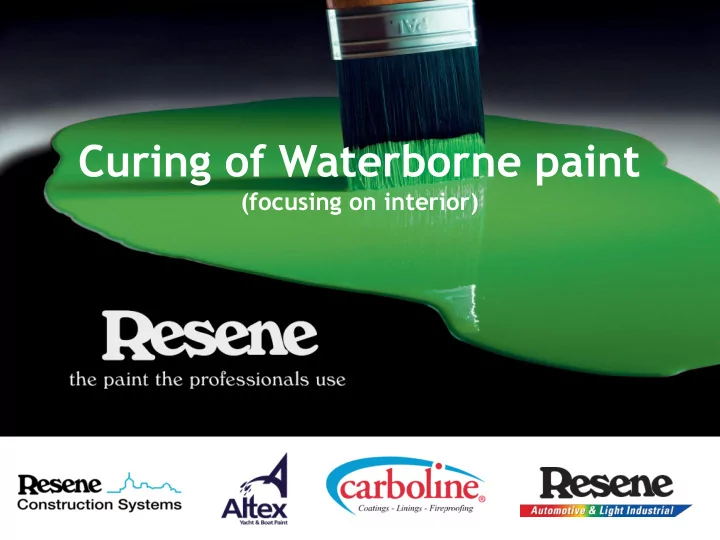

Curing of Waterborne paint (focusing on interior)
General paint curing methods • Waterborne Evaporation • Oil based Oxidation (reacts with oxygen) • 2K Epoxy/Urethane Chemical reaction • Moisture cured polys Reaction with moisture in air
Key Points on waterborne curing Waterborne paint dries through the evaporation process • (water & solvents simply evaporate into the atmosphere) Ideal drying conditions are 15-20°C, less than 75% RH, with • gentle airflow to move moisture away Coalescing & full curing of a coating takes around 5-7 days in • ideal conditions (ie doing all the things it needs to so it’s durable) In cooler months if your clothes on the line aren’t drying • your paint won’t either
What’s in a can of paint? • BINDERS stick the paint together, form a film and give adhesion • PIGMENTS to colour the paint, control gloss, prevent corrosion, add bulk and other properties. • SOLVENTS to make paint useable. • THICKENERS to hold the wet paint in suspension, prevent sagging. • ADDITIVES to do all the little, but important jobs.
Time taken through drying/curing process (in ideal conditions) As you see the initial release of moisture occurs within a few hours however full coating coalescing can take many days in ideal conditions
Coalescing process (in simple terms) Stage 1 & 2 along with early phase of Stage 3 occurs in a matter hours End of Stage 3 process takes many days
What affects drying & curing of paint?
Humidity Lower Humidity levels assist drying • Moisture has to evaporate into atmosphere • Over 75% Relative Humidity waterborne paint will struggle • to dry, over 85% RH it won’t dry • Waterborne paint increases RH of an Interior as moisture evaporates into atmosphere Common problem areas: • Painting regionally with High humidity (Summer & Winter) • Residential & Commercial interior masked out with film and little airflow • Painting into evening then property closed up
Airflow • The moisture in paint has to go somewhere • Needs to be moved out and away • Open doors and windows to allow airflow through • Use extraction fan units Common problem areas: • Residential interior masked out with film and not removed after painting • Commercial interiors with no airflow or extraction units • Painting into evening then property closed up
Temperature Warmer temperatures speed up drying (additives can be used • to slow drying) Cooler temperatures slow drying • Too cold and it won’t dry • Common problem areas: Warmer - If paint dries too quickly difficult to achieve a • quality finish (over textured surface and brush & roller marks occur) • Cooler – patchiness can occur due to retained moisture in coating. If too cold coating may never coalesce properly
Re-coat time Recoat times are based on ideal curing conditions. 2 hours • in ideal conditions. Low airflow, high humidity, low temp will extend re-coat • times Where issues occur: 2 coats applied to soon – patchiness & sheeriness will • present as moisture for 1 st coat hasn’t had time to release
Time (generally) Coatings require time to fully “set up” and cure to access their • performance potential even in good conditions In adverse conditions curing time can be greatly extended • Where issues occur: Residential Interiors in colder monthly • Commercial properties finished and furniture etc (or workers) • move in next day Overnight painting in commercial environments still operating •
Common issues when drying/curing affected Surfactant Leaching Burnishing When waterborne coatings are hit Surface subjected to scrubbing with moisture too soon after painting. /rubbing soon after painting (often by Water mark are left on the surface. commercial cleaners) leaving visible Typically occurs in Bathrooms marks across surface. Far more obvious in darker colours
Important factors to focus on for Interiors • AIRFLOW open windows/doors, use extraction fans Good airflow is needed • HUMIDITY be aware of high humidity • • TEMPERATURE be aware of high or low temps and work accordingly • TIME PERIODS give paint a chance to cure fully
Recommend
More recommend